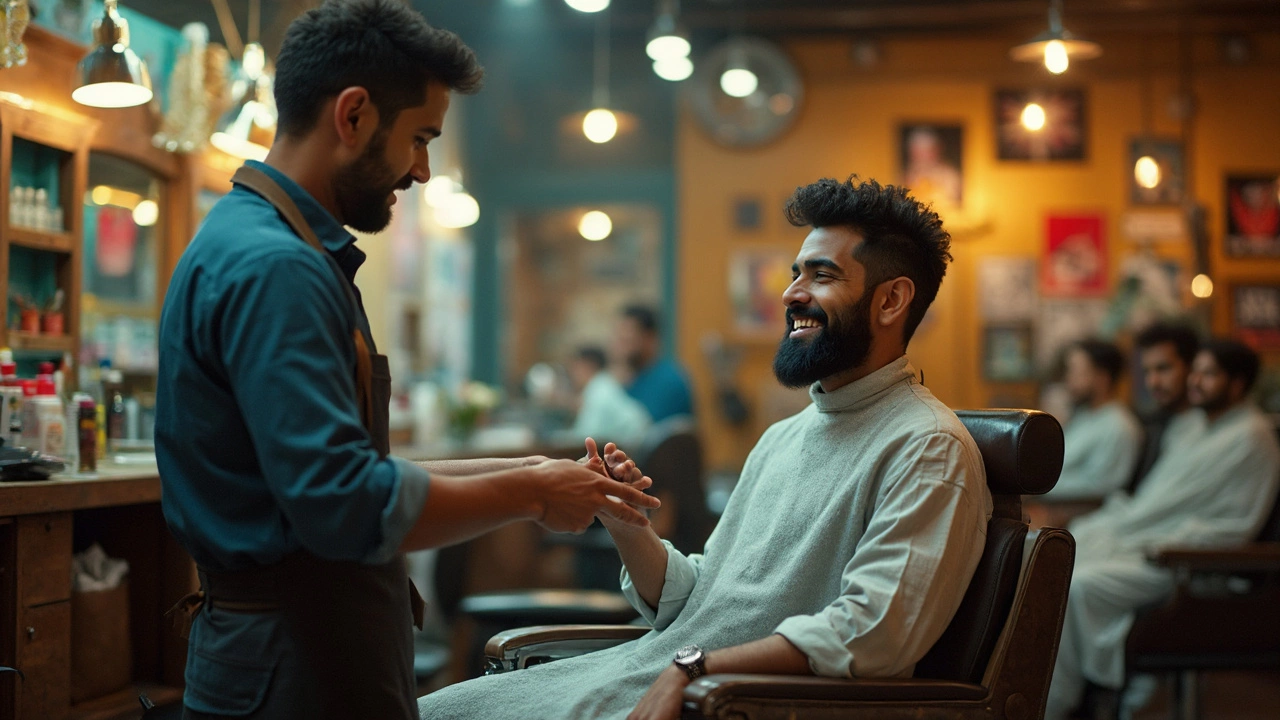
Is tossing just two dollars on the salon counter after a haircut actually enough? Lots of us wrestle with this every time we get a trim. The answer isn’t simple, but it matters more than you think—especially if you want your stylist to smile when you book your next appointment.
For most salons in the U.S., tipping isn’t optional. It’s baked into the whole experience, sort of like adding sprinkles to your kid’s ice cream. The average tip hovers around 15% to 20% of your total bill, but there are exceptions—and some shops even pool tips, changing the game entirely.
When your haircut costs $20 and you leave just $2, that’s a 10% tip. If you paid $50 and still tipped $2, you’re looking at just 4%. Ouch, right? That kind of tip sends a message, even if you don’t mean to. It helps to know what that money means to your stylist. Most aren’t raking in giant paychecks. Tips can mean the difference between making rent and living on ramen.
- Typical Tipping Culture at Beauty Salons
- How Much Do Stylists Actually Expect?
- Factors That Affect How Much You Should Tip
- Real-Life Scenarios: When Is $2 Enough or Not?
- Smart Ways to Handle Tipping at Salons
Typical Tipping Culture at Beauty Salons
Walking into a beauty salon, most folks already know they're expected to leave a tip. But what’s actually normal? In the United States, tipping after a haircut is pretty much standard, kind of like adding a side of fries to your burger—it’s just what you do. Most stylists count on tips to make their job worth it each week.
Across the country, the haircut tip usually lands between 15% and 20% of your total bill. Some cities like New York or Los Angeles see even higher tips, sometimes up to 25%, especially for complicated color or styling. But these are the usual numbers salons see every day:
| Service Cost | 15% Tip | 20% Tip |
|---|---|---|
| $20 | $3 | $4 |
| $40 | $6 | $8 |
| $60 | $9 | $12 |
If you only tip $2, you can see how fast that falls below the typical range. Lots of people don’t realize how much stylists depend on these extra bucks: the Bureau of Labor Statistics reported in 2023 that the median pay for barbers and hairstylists hovers around $16 an hour—not including tips. Some salons share the tip pool, so your money might even get split between the person who washed your hair and the stylist with the scissors.
Different countries handle this differently. In Japan, for example, tipping isn’t really a thing at salons. But in Canada or the UK, the expectation is way closer to the U.S. average. If you move or travel a lot, it’s smart to double-check the local custom, so you don’t end up looking like a cheapskate by accident.
A lot of folks still pay cash tips, even if they swipe a card for the service itself. That’s because stylists usually get their cash tips right away—no waiting for the boss to hand it over. Just remember, your tip isn’t just a random bonus; it’s a real part of a stylist’s paycheck and keeps the salon humming.
How Much Do Stylists Actually Expect?
Most stylists expect tips to land somewhere between 15% and 20% of your total bill, no matter if you’re at a high-end beauty spa or the budget haircut place a block from your house. They count on these tips since their base pay can be way lower than you’d imagine. Did you know many stylists make close to minimum wage before tips come in?
Check out this quick breakdown of what the math looks like at different price points in the U.S.:
| Service Price | 15% Tip | 20% Tip |
|---|---|---|
| $20 | $3 | $4 |
| $40 | $6 | $8 |
| $60 | $9 | $12 |
| $100 | $15 | $20 |
If you leave haircut tip amounts way lower than this range—say, just two bucks—it pretty much signals you weren’t happy or didn’t know what was normal. For a quick trim at a chain salon, some people round up, but even there, regulars who want decent service usually tip closer to 15%.
Stylists chat about these numbers, too. At busy salons, that customer who always tips well is remembered in a good way. Behind-the-scenes, tips end up covering gas, supplies, even lunch. For anyone unsure about exactly what to do, just ask. Most stylists would rather you ask than leave them guessing (and let’s be honest, no one wants weird tension at their next appointment).

Factors That Affect How Much You Should Tip
Not every haircut is the same, so the tip doesn’t need to be one-size-fits-all either. A bunch of things come into play, from how much you spend to how happy you are when you leave the chair. Thinking about these makes sure you’re not under-tipping by accident.
- Salon Location: Getting a trim in Manhattan is not the same as getting one in a small town. In big cities, tipping 20% is pretty much the standard. Smaller places might be chill with 15%. Local culture plays a huge role.
- Service Quality: If your stylist nailed your faded sides or rescued your accidental home-bang disaster, a bigger tip is fair. If they rushed or barely listened, you might stick closer to the lower end.
- Type of Service: Simple buzz cuts take less time than color, highlights, or styling. More work or longer appointments deserve more than the usual percentage.
- Salon Policy: Some places (mainly chain salons) have strict tipping rules or even add a tip automatically. Sometimes salons also pool tips with assistants—especially if someone else washed your hair.
- Your Regular Stylist: If you always go to the same person, tipping a bit extra now and then builds goodwill. It’s the beauty world’s version of being a regular at your favorite bagel shop.
Here’s a quick look at what most people actually tip for a haircut tip in the U.S.:
| Service Cost ($) | Typical Tip (%) | Tip Amount ($) |
|---|---|---|
| 20 | 15% - 20% | 3 - 4 |
| 35 | 15% - 20% | 5 - 7 |
| 50 | 15% - 20% | 7.50 - 10 |
| 100 (color/highlights) | 15% - 20% | 15 - 20 |
If money’s tight, don’t sweat it too much—stylists usually understand situations when you can’t tip big. A quick explanation and some genuine appreciation go a long way. But if you can, tipping a fair amount really does help pay the bills for your salon professionals.
Real-Life Scenarios: When Is $2 Enough or Not?
So, is 2 bucks enough for a haircut tip? It depends on a few real-world details. If you’re just getting a quick trim at an old-school barber shop—say they buzz your kid’s head for $10 and hand you a lollipop—then $2 might actually get a nod of approval. But that’s the exception, not the rule these days.
The haircut tip norm shifts if you’re at a chain salon where haircuts run $20-$35, or at a trendy spot charging $50 and up. For quick walk-in barbers or discount chop shops (think: your classic $12 men’s haircut joint), a $2 tip means you’re at about 15-17%. In these places, the staff may expect it and not give you side-eye. But in salons with higher prices, $2 starts to feel a little light—sometimes awkwardly so.
Let’s lay out a few scenarios in a table for easier comparison:
| Salon Type | Typical Haircut Cost | $2 Tip (%) | How It Feels to Your Stylist |
|---|---|---|---|
| Old-school barber | $10 | 20% | Pretty standard, usually fine |
| Budget chain (like Supercuts) | $20 | 10% | Below average—might seem stingy |
| Trendy salon | $40 | 5% | Very low—a bit awkward |
| High-end stylist | $80 | 2.5% | Makes your stylist feel unappreciated |
So, when does $2 make sense? Usually only for a simple, very cheap cut—think crew cuts or quick trims on screaming toddlers (ask me about Orin’s meltdown sometime). If you’re getting a full wash, style, or color job, $2 probably won’t cut it, no matter how tight your budget is.
- If the service is fast, basic, and under $15, go ahead and leave $2—no shame.
- If your cut is $20 or more, aim for at least 15-20% unless something went really wrong.
- Did your stylist work some serious magic, calm your nervous kid, or squeeze you in last minute? Anything extra will mean a lot to them.
People who stick to $2 in mid- or high-range salons might want to think twice. Workers at these places often rely on tips as a big part of their pay. And if you’re a regular, low tips could mean slower service or tougher appointments to get in the future.

Smart Ways to Handle Tipping at Salons
Let’s face it: no one wants to feel awkward about how much cash to leave after a haircut. Whether you’re new to a salon or a loyal regular, tipping right keeps both you and your stylist happy. Here’s how to nail it every time.
First, know that the haircut tip isn’t just extra cash for your barber or stylist—it’s a real chunk of their income. Most stylists expect tips on every visit, and some even have to share tips with assistants. If you aren’t sure what’s fair, remember that the standard is usually 15% to 20% of the total price.
| Service Price | 15% Tip | 20% Tip |
|---|---|---|
| $20 | $3 | $4 |
| $40 | $6 | $8 |
| $60 | $9 | $12 |
If math isn’t your thing, most salon receipts make it easy to add a tip on your card. But, cash is still king. Sometimes, if tips are put on a credit card, stylists have to wait to get the money or even lose a bit to processing fees. Got cash? Tip in exact bills—you’ll make their day.
- Check the bill first. Some higher-end salons add a service fee. That’s not always a tip, so ask if you aren’t sure where that fee goes.
- Say thanks in person. A friendly word goes further than a silent nod. Show a little appreciation; it honestly helps build trust for your next visit.
- Multiple services mean multiple tips. If the person who shampoos is different from your main stylist, slip that shampoo tech $2 or $3 directly.
- Have cash backups. If you forgot cash, ask your salon if you can Venmo or use another digital payment. Some stylists put up QR codes at their stations now.
- Tip extra for fixes or awesome work. If your stylist squeezes you in for a bang trim or a last-minute save, a few extra bucks isn’t out of line.
If money’s tight, don’t just skip the tip altogether—say something honest. Most stylists get it, and a sincere “I’ll tip extra next time” goes over better than leaving nothing behind.
 Hair Care
Hair Care